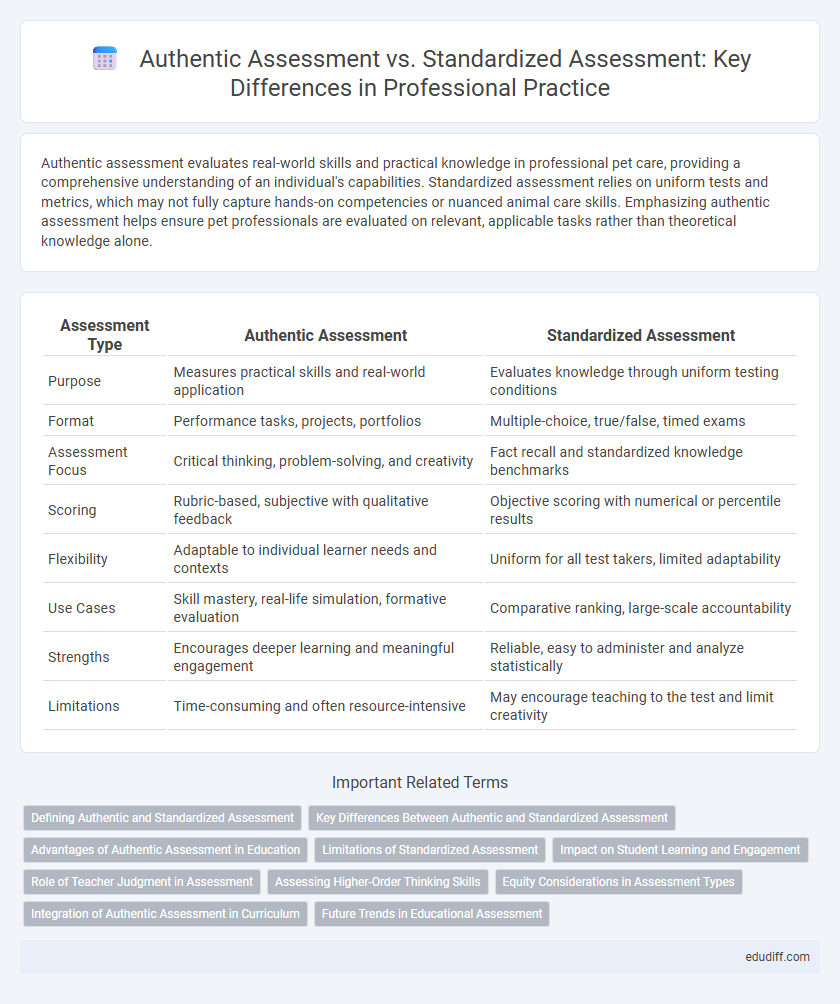Authentic assessment evaluates real-world skills and practical knowledge in professional pet care, providing a comprehensive understanding of an individual's capabilities. Standardized assessment relies on uniform tests and metrics, which may not fully capture hands-on competencies or nuanced animal care skills. Emphasizing authentic assessment helps ensure pet professionals are evaluated on relevant, applicable tasks rather than theoretical knowledge alone.
Table of Comparison
| Assessment Type | Authentic Assessment | Standardized Assessment |
|---|---|---|
| Purpose | Measures practical skills and real-world application | Evaluates knowledge through uniform testing conditions |
| Format | Performance tasks, projects, portfolios | Multiple-choice, true/false, timed exams |
| Assessment Focus | Critical thinking, problem-solving, and creativity | Fact recall and standardized knowledge benchmarks |
| Scoring | Rubric-based, subjective with qualitative feedback | Objective scoring with numerical or percentile results |
| Flexibility | Adaptable to individual learner needs and contexts | Uniform for all test takers, limited adaptability |
| Use Cases | Skill mastery, real-life simulation, formative evaluation | Comparative ranking, large-scale accountability |
| Strengths | Encourages deeper learning and meaningful engagement | Reliable, easy to administer and analyze statistically |
| Limitations | Time-consuming and often resource-intensive | May encourage teaching to the test and limit creativity |
Defining Authentic and Standardized Assessment
Authentic assessment evaluates students through real-world tasks that demonstrate practical application of knowledge, emphasizing critical thinking and problem-solving skills. Standardized assessment measures student performance using uniform procedures and scoring, allowing for comparison across different populations and settings. Both assessment types serve distinct educational purposes, with authentic assessment fostering deeper understanding and standardized assessment ensuring objective measurement.
Key Differences Between Authentic and Standardized Assessment
Authentic assessment evaluates students through real-world tasks that demonstrate practical skills and critical thinking, while standardized assessment relies on uniform tests with multiple-choice or short-answer questions to measure knowledge across a broad population. Authentic assessments prioritize context-specific performance and personalized feedback, whereas standardized assessments emphasize reliability, validity, and comparability of scores. The key difference lies in the purpose: authentic assessment fosters deeper learning and application, whereas standardized assessment provides quantifiable data for benchmarking and accountability.
Advantages of Authentic Assessment in Education
Authentic assessment offers a comprehensive evaluation of students' skills by emphasizing real-world tasks and critical thinking, enhancing their ability to apply knowledge in practical situations. It promotes deeper learning and engagement by allowing learners to demonstrate understanding through projects, presentations, and portfolios rather than multiple-choice tests. This type of assessment fosters creativity, problem-solving skills, and collaboration, which are essential for success in professional environments.
Limitations of Standardized Assessment
Standardized assessments often fail to capture critical skills such as creativity, critical thinking, and problem-solving, limiting their effectiveness in measuring overall student competence. These assessments typically emphasize rote memorization and multiple-choice formats, which can hinder authentic evaluation of real-world application and higher-order thinking. Furthermore, standardized tests may disadvantage diverse learners due to cultural bias and a one-size-fits-all approach, reducing the fairness and inclusivity of educational measurement.
Impact on Student Learning and Engagement
Authentic assessment enhances student learning by focusing on real-world skills and critical thinking, promoting deeper engagement and meaningful knowledge retention. Standardized assessments often emphasize memorization and test-taking strategies, which may limit student creativity and reduce motivation. Research shows that authentic assessments improve student confidence and active participation, leading to better academic outcomes.
Role of Teacher Judgment in Assessment
Teacher judgment plays a critical role in authentic assessment by providing nuanced, context-specific insights into student learning that standardized tests often overlook. In authentic assessment, educators evaluate students' skills and knowledge through real-world tasks, allowing for a more personalized and formative understanding of progress. Standardized assessments rely on uniform scoring criteria, limiting the teacher's ability to interpret individual student needs and learning strategies beyond quantitative results.
Assessing Higher-Order Thinking Skills
Authentic assessment evaluates higher-order thinking skills through real-world tasks requiring analysis, synthesis, and evaluation, fostering deeper understanding and practical application. Standardized assessment primarily measures lower-order cognitive abilities like recall and recognition via uniform testing formats, limiting insight into complex problem-solving capabilities. Emphasizing authentic assessment enhances critical thinking and creativity essential for professional competence in dynamic environments.
Equity Considerations in Assessment Types
Authentic assessment prioritizes equity by evaluating students through real-world tasks that reflect diverse skills and cultural backgrounds, allowing for more inclusive measurement of competence. Standardized assessments often present equity challenges due to their uniform format and cultural biases, which may disadvantage students from varied socioeconomic or linguistic contexts. Implementing authentic assessments supports equitable education by accommodating different learning styles and providing meaningful opportunities for all students to demonstrate their knowledge.
Integration of Authentic Assessment in Curriculum
Authentic assessment integrates real-world tasks that mirror professional practice, enhancing curriculum relevance and student engagement. Incorporating portfolios, simulations, and performance-based evaluations aligns learning outcomes with industry standards and critical thinking skills. This approach fosters deeper understanding and transferable competencies compared to traditional standardized tests.
Future Trends in Educational Assessment
Future trends in educational assessment emphasize a shift towards authentic assessment methods that evaluate students' real-world skills and critical thinking through project-based tasks and portfolio evaluations. Technological advancements enable adaptive, personalized assessments that move beyond traditional standardized testing to provide more accurate insights into individual learning progress. The integration of AI and data analytics fosters continuous, formative feedback, supporting educators in tailoring instruction and enhancing student engagement.
Authentic Assessment vs Standardized Assessment Infographic

 edudiff.com
edudiff.com